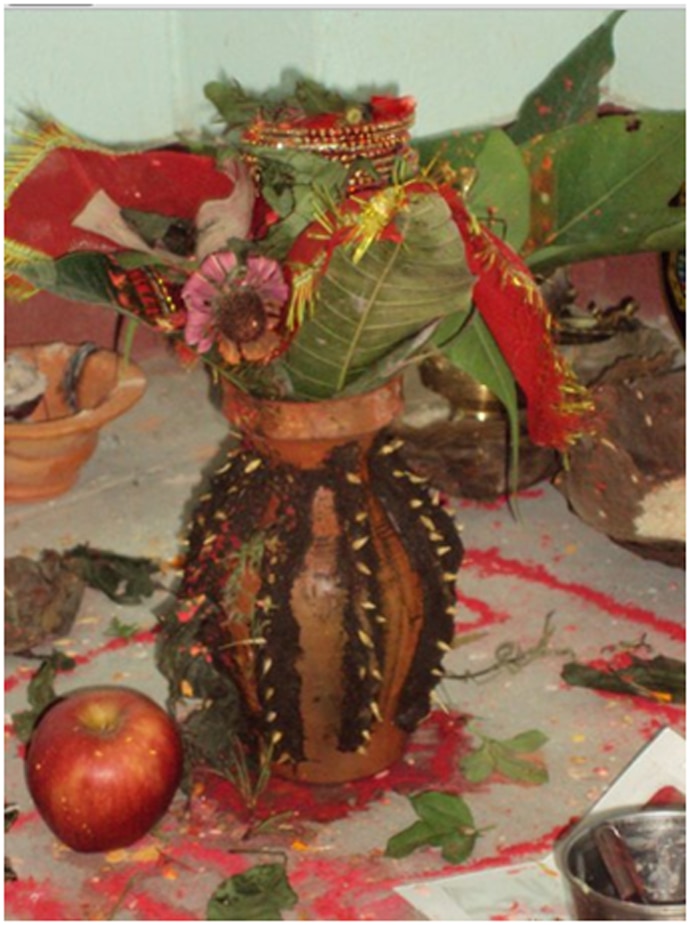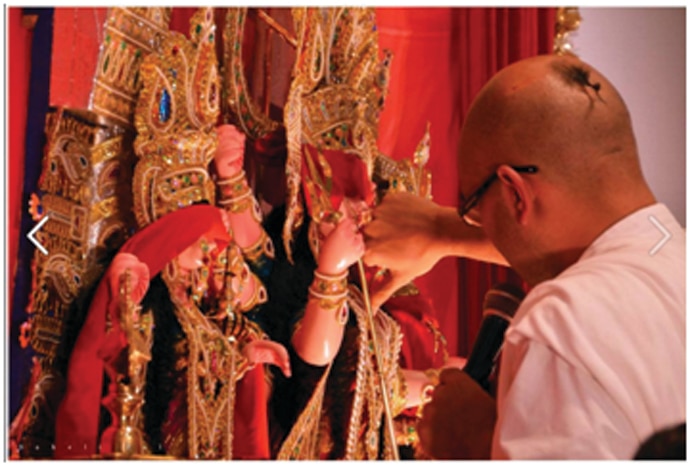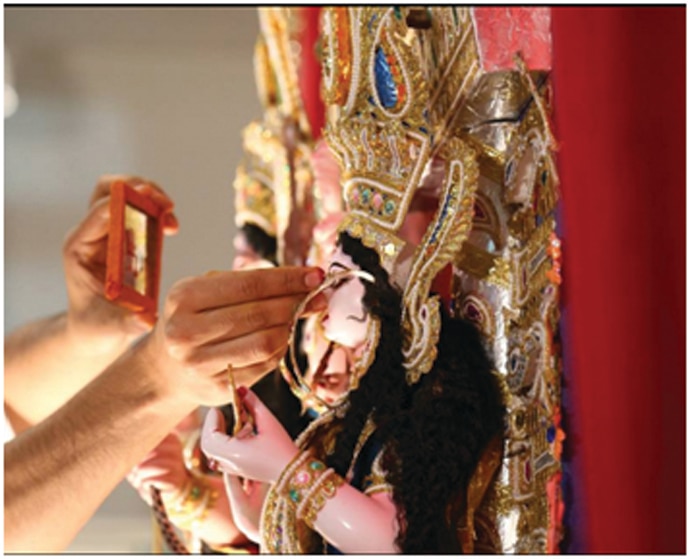How Durgāpūjā marks the confluence of everything Hindu

Śāradiya (autumnal) worship of Mahādevī falls on the first nine days of the śukla (waxing) half of Āśvina. Mostly a time of solemnity and worship of the goddess in her different aspects, Navrātrī’s most arresting and celebratory manifestation is, without a doubt, Durgāpūjā. Besides the quintessential colours, sights, sounds and smells what makes it so iconic? As Durgāpūjā concludes across the country (world, even!), a recapitulation yields a wealth of information about various streams that constitute Hinduism.
The true power of Durgāpūjā stems from its being a confluence of every powerful course of Hindu practice.
It is open to every caste, every gender, every devotee - rich or poor, aristocratic or tribal, virtuous, amoral, even criminal. The cosmic mother does not turn her back on any of her children. Although privileged by Bengalis, Durgāpūjā transcends geographical and cultural boundaries. It is constituted of pre Vedic, Vedic, Purāṇic, Tantric and Bhakti practices. In terms of Vedic categories, it qualifies asnitya (compulsory), naimittika (occasional), and kāmya (for a special desire). Pivotal to Śāktas, it is dear to Śaivas, Durgā being identified with Pārvatī and also to Vaiṣṇavas, as she dwells in the chest of Viṣṇu (vakṣassthalāśraye) from where she descends to her temporary abode in respectivepūjālayas during Navratrī.
Durgāpūjā commences on the ṣaṣṭhī (sixth day) of Navratrī with āgamani (arrival) songs. I have yet to meet a Bengali who doesn’t get misty eyed remembering Birendra Krishna Bhadra’s "Mahālaya" played at dawn on All India Radio.
Often, but not always, a purohita is entrusted with the entire pūjā which lasts for several hours each day, over a five-day period. Using mudrās and mantras he invokes all the sacred rivers to be present (saṃnidhi) in water with which he purifies the area, the offerings, his own body and all the elements through a series of śuddhis. He removes all obstacles and inimical spirits by scattering mustard seeds, and pronounces the saṅkalpasūkta expressing the purpose of the pūjā.
From the simplest darśana in the privacy of one’s home to the most elaborate community ceremony, "pūjo" takes many forms.
Instructions for the pūjā appear with variations in manuals like Purohita Darpaṇa. A description of the common core is presented here. Pūjā begins with bodhana (awakening) of the goddess. This is done through ghaṭasthāpnā (establishment of a pot) before a bilva tree/branch, on a yantra which might be a simple triangle or the complex sarvatobhadramaṇḍala. Devī is awakened from her latent form in all of existence first in the pot, then progressively in amaṇḍala, a selection of nine plants (navapatrikā), a conch shell, amūrti and finally in a living, pre menarche girl (kumārī).
Appendages to DurgāSaptaśatī like Pradhānika Rahasya, VaikṛtikaRahasya and MūrtiRahasya explain how the goddess is brought from her avyakta (un-manifest) state to vikṛti (being manifest).
 |
| Ghaṭasthāpanā on the first day of Durgāpūjā |
The awakening is followed by an anointment (adhivāsanam) of all the ritual forms where in Devī will manifest. The anointment is done with a variety of materials including – sandalwood paste, soil, a small stone, unhusked rice, dūrva grass, flowers, fruit, curd, ghee, kājal, cow bile (gorocanā), vermillion (kuṅkuma), a swastika, gold, silver, a mirror and a dīyā. The anointment takes place with appropriate Sanskrit mantras. The cluster of nine plants represent Devī in her divine vegetative form, bestowing fecundity. She resides in the plants as Brāhmaṇī, Kālikā, Durgā, Kārtikā, Raktadantikā, Śivā, Śokarahitā and Lakṣmī.
This element of pūjā is considered to be related to the extremely ancient, pre Vedic worship of yakṣīs who dwell in trees.
On the following day, Devī is bathed in her various abodes. The purohita has previously tied a thread on her wrist, ensuring his own protection, much like rakṣābandhan. The navapatrikā is bathed in pañcagavya(milk, cow urine, cow dung, curd, ghee) and nine types of water. The accompanying litany tells us that Devī dwells in the bosom of Viṣṇu (Viṣṇuvakṣaḥsthalāśraye); she is the beloved of Śiva (Harapriyā), the abode of glory (Śriniketā), giver of life (Prāṇadāyinī), grants all desires (Kāmapradā), removes sorrows, sins, hunger and bestows all accomplishments (Savrasiddhipradā).
 |
 |
| cakṣūrdāna and prāṇapratiṣṭhā via @EdinHinduMandir |
She is the cause, embodiment and increaser of victory (Jayārūpā, Jayāhetu and Jayābardhanā).
The reflection of the mūrti in a mirror is then bathed symbolically.The purohita rubs rice powder on the mirror and washes it with pañcagavya and water from a special jar with a spout (bhṛṅgāra) reminiscent of ancient royal consecration. Accompanying mantras explain that she is being bathed by a host of entities both benevolent and malevolent, divine and mundane, including sacred rivers, gods and goddesses, the Mothers (mātṛs), planets, sages, sacred places, the divisions of time, and demons. She is then bathed with a pot that bears several holes (sahasradhāra) symbolising the water of countless sacred rivers.
As the goddess is cleansed, so are all the devotees present in the pūjā.
The purohita then "awakens" the goddess in the mūrti by giving it sight (cakṣurdāna*) by applying kājal to her eyes with the stalk of a bilva leaf, and giving her vital breath (prāṇapratiṣṭhā*) by pressing a flower to her bosom. These are conferred by the recitation mantras which he receives as part of a special initiation (dīkṣā). She is then honoured with an elaborate sixteen-part devotional service (ṣoḍaśopacāra), inspired by Vedic gṛhya sutras.
 |
| cakṣūrdāna and prāṇapratiṣṭhā via @EdinHinduMandir |
Devī is offered a seat (āsana), her feet are washed (pādya), food is offered (naivedya), including madhupārka, betel nut (tāmbūla), and modaka. A number of feminine accoutrements are offered including a conch-shell bangle, vermillion, collyrium, and a mirror. Flowers and flower garlands, fragrant incense, and flame worship (ārati) are part of the offerings.
Aṣṭamī (eighth day) sees the installation of a special yantra and the worship of her weapons (āyudhapūjā). The eight śaktis of Durgāare invoked in the eight petals of a lotus in amaṇḍala. Starting with the east and moving in a clockwise direction, the purohita invokes Ugracaṇḍā, Pracaṇḍā, Caṇḍogrā, Caṇḍanāyīkā, Caṇḍā, Caṇḍavatī, Caṇḍarūpā, and Aticaṇḍikā respectively. He then invokes and worships the sixty-four yoginīs in thecenter of the yantra.
According to legend, Durgā received powers and weapons from all the gods to kill the powerful Mahiṣāsura, who they could not destroy in accordance with a boon. In the old days, the weapons would be real ones, used in war. But these days, not so much. The weapons are often taken away by devotees as souvenirs after the pūjā.
The climax of the pūjā falls for many on the highly auspicious hour joining the eighth and the ninthdays known as "sandhi". It is believed that Mahiṣāsura was killed during this hour. In traditional pūjās even today a blood offering is made during sandhi pūjā. Devotees invoke her in her dreadful forms - Cāmuṇḍā and Kāli. A black goat (chāgabali) or a buffalo is sacrificed. However most people use a substitute – a kuṣmāṇḍa melon, a coconut or a banana. A pre-menarche girl is worshipped as the living presence of the goddess.
In North India, particularly Punjab, this pūjā knows as "kanjakaan", when pre-pubertal girls are dressed up, worshipped and given gifts. My grandmother always snorted in derision saying, if this was done all year round instead of just one day, "deshkakalyanhojaye".
Mahānavmī sees a repetition of previous worship with the addition of a Vedic styled "homa’ or fire sacrifice.
This homa follows the apex sandhipūjā during which 108 lamps are lit, more in keeping with bhakti-bhāva, than with Vedic yajña. And finally we have Vijaya-daśamī, when the goddess is sent home. She is worshipped both as Nirmālyavāsinī (abiding in purity) and Ucchiṣṭacaṇḍālinī (the remainder, the impure), and requested to depart along with all her Śaktis to her highest abode (paramasthāna). She is not dismissed entirely, as the accompanying mantras inform us. She is asked to remain in the waters, the earth and the home (jale, gehe ca bhūtale), from where she will be awakened the following year. Finally devotees, simultaneously joyful and sad,take her for visarjana (immersion in a pond, lake or river.)
Prior to immersion, the ladies of the house feed each other sweets and betel nut in a rite known asvarana/barana. They also smear the mūrti with sweets and drape it with betel leaves. One explanation for this ritual is that Durgā is returning to her husband’s abode atop Mt. Kailāśa, where she will experience great hardship during the ensuing year with the austere Yogeśvara, Śiva! The sweets will fatten her up for the year ahead.
It is the final touch to the gracious treatment she has received in her "maikā", the memory of which will encourage her to return again the next year.
Read more about the goddess Durgā and the significance of her worship in these excellent studies here:
1. http://cup.columbia.edu/book/revelry-rivalry-and-longing-for-the-goddesses-of-bengal/9780231129183
3. http://www.sunypress.edu/p-3599-ritual-worship-of-the-great-god.aspx
(cakṣūrdāna and prāṇapratiṣṭhā via @EdinHinduMandir)

